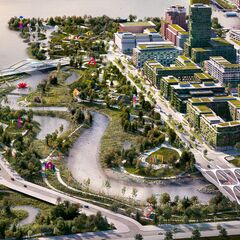I few more buildings, closer together, and more of them closer to the higher side of the range is probably better than towers. Plus then you don't have to fight with the federal government over the island airport approach.
Something to remember here is that under Toronto's current planning regime (and it's similar elsewhere), as you increase height, minimum separation distances also rise, particularly when you transition from mid-rise to hirise.
The midrise guidelines generally call for a minimum 20M separation distance, but the tall building guidelines call for 25M.
Broadly, the 20M guideline applies up to 11s in height.
Of course, there a host of other rules around height, such as angular plane that can come into play as well.
There likely is room to tweak here, if desired......ie. 6s to 7s etc. But larger moves trigger lots of problems.
Not merely the 'rules' either.
Infrastructure is being designed and has been designed with a certain level of development in mind (sewers, watermains, electrical distribution etc.)
Re-opening the proverbial can-of-worms, may result in design changes, additional costs and some measure of delay.




















